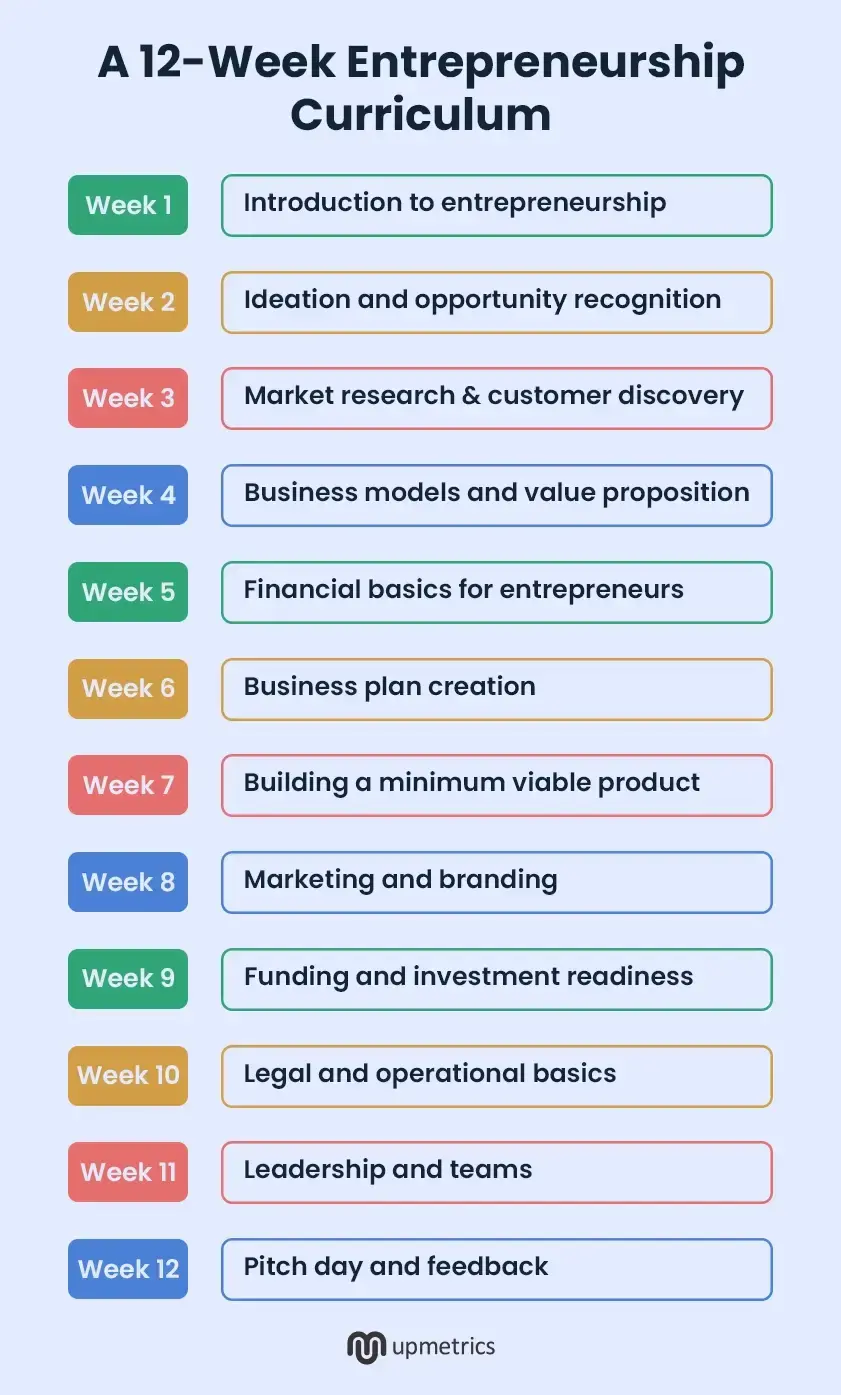An entrepreneur becomes a person with an adaptive and creative mind. An entrepreneur becomes a person who’s constantly spotting opportunities.
In short, an entrepreneur becomes of a specific MIND 🧠. And that needs to be cultivated and nurtured through the right curriculum.
But what would the entrepreneurship curriculum contain?
Let’s find out!
What is an entrepreneurship curriculum?
An entrepreneurship curriculum is a structured educational program designed to teach people the ins and outs of entrepreneurship including the mindset, skills, and tools needed to identify opportunities, develop ideas, and launch sustainable ventures.
Unlike traditional business courses, designed for people with an education in business, this is for everyone including students, aspiring entrepreneurs, or professionals. That’s because instead of emphasizing management, an entrepreneurship curriculum focuses on innovation, adaptability, and real-world application.
A 12-week entrepreneurship curriculum
Below is a step-by-step, week-by-week breakdown of a 12-week entrepreneurship curriculum that blends theory with hands-on learning.

Week 1: Introduction to entrepreneurship
It’s a course for all future entrepreneurs, so week 1 should be about making them comfortable with the concept of entrepreneurship.
So start by explaining what entrepreneurship means, the types of entrepreneurs, the role of entrepreneurship in society, and its impact on the global economy.
Other activities and topics you can focus on, include:
- Explain the winning mindset and characteristics needed for success.
- Discuss the latest entrepreneurial trends, such as social entrepreneurship, the sharing economy, and technological advancements, to ensure students stay ahead of the curve.
- Discuss case studies of successful entrepreneurs (both giants like Elon Musk as well as local changemakers).
- Let participants share why they are interested in entrepreneurship and their aspirations.
Week 2: Ideation and opportunity recognition
Entrepreneurship can’t exist without ideas or the ability to spot opportunities at the right time.
So in week two, with your target students all confident about the basics, you need to equip students with proven techniques for:
- Generating business ideas: Using creativity and critical thinking activities like mind mapping, SCAMPER (Substitute, Combine, Adapt, Modify, Put to another use, Eliminate, Reverse), or design thinking.
- Spotting opportunities: by making students understand gaps in markets
- Evaluating the feasibility and viability of their concepts: by understanding customer demand, scalability, and market analysis.
That’s not all. Businesses are real. So you want to bring the realness to the education by incorporating real-world case studies, group activities, and pitch sessions to simulate entrepreneurial challenges.
This will help show entrepreneurs how important it is to observe and be curious about everyday inefficiencies as well as opportunities.
Week 3: Market research and customer discovery
In week three, your focus should be on “understanding the target audience and validating the business idea”.
So teach your curious entrepreneurs how to do thorough market research by covering key topics like:
1. The importance of market research
First explain how understanding the market reduces risks, identifies opportunities, refines ideas, and validates concepts.
Then emphasize that customer feedback is essential to creating solutions that truly address pain points.
2. Tools and methods for market research
There are multiple tools available, including surveys, interviews, and online platforms like social media, review websites, and forums. Introduce all of these tools as they help gather actionable insights as well as understand customer preferences and complaints.
3. Defining target personas
Break down the process of creating customer personas based on demographics, psychographics, behaviors, and pain points.
Then provides your to-be entrepreneurs with examples to show how personas guide marketing, product development, and customer interactions.
Once done, you can also ask your course participants to conduct 5 customer interviews at the end of the week to validate their ideas. This activity will prepare them for real-world market research.
Week 4: Business models and value proposition
The next 7 days are about creating a sustainable business model. That’s how participants can create strong foundations for long-term success.
So don’t forget to consider to core learning concepts:
Business Model Canvas (BMC):
Introduce the BMC as a one-page visual tool to break down and visualize the core elements of a business. Make sure you cover the BMC’s building blocks, including:
| Best Cities for Food Trucks | Worst Cities for Food Trucks |
|---|---|
| Key Partners, Activities, and Resources | Collaborations, Operations, and Assets Essential Key Partners: Collaborators like suppliers or alliances. Key Activities: Core operations (e.g., production, marketing). Key Resources: Vital assets (e.g., technology, funding, personnel). |
| Value Proposition | The Unique Problem-Solving Promise Explains how the product/service addresses customer needs or solves problems, offering benefits competitors lack (e.g., cost savings, convenience, innovation). |
| Customer Segments, Channels, and Relationships | Customer Segments: Groups served based on demographics, behaviors, or needs. Channels: Platforms for delivering value (e.g., online, retail). Customer Relationships: Interactions, from personalized support to self-service. |
| Revenue Streams and Cost Structure | Revenue Streams: Income sources (e.g., sales, subscriptions, licensing). Cost Structure: Fixed and variable costs to maintain operations and deliver value sustainably. |
Once the curriculum participants are clear about the BMC concept, make them draft their Business Model Canvas and present it to the class for hands on learning.
Value proposition design
The second learning concept for this week is crafting a compelling value proposition.
So you want to include a quick course on value proposition design. It’s a structured process consisting of several steps to create a clear, compelling statement highlighting how the product solves customer problems and delivers unique benefits.
Use tools like the value proposition canvas to refine ideas and encourage participants to try the same.
Week 5: Financial basics for entrepreneurs
Money is fuel for any business and your entrepreneurs need to understand this aspect of a business in and out.
Here’s a quick list of material this week of financial basics will include:
Revenue, costs, and profit basics
- Differentiate between fixed and variable costs.
- Explain how revenue streams contribute to overall income.
- Showcase how profit is calculated and its importance in sustaining a business.
Financial projections and budgeting
- Introduce the concept of expenses and sales forecasting.
- Discuss the role of budgets in controlling costs and tracking financial health.
- Highlight tools and techniques for creating simple, actionable financial plans.
Activities?
On the last day or two of the week, you can make participants create a basic revenue model for their idea.
Week 6: Business plan creation
A business plan is an entrepreneur’s ammunition as it gains you investors, sets a roadmap for the business and operations, improves transparency for internal and external teams, and more!
So week 6, teach your students how to build this powerful tool.
Start by introducing students to the different sections involved in a quality business plan, such as executive summary, products and services, market analysis, financial projections, operational planning, as well as marketing and sales strategies.
Explain each of these and how they can add or remove sections in a business plan depending on the reader (investors, banks, internal team, or partners) and your purpose.
Week 7: Building a minimum viable product (MVP)
Week 7 can be about diving into the business instead of the concepts of business and focus on developing and testing a prototype. Because what’s a business without something to sell?
So here’s everything you can include in your week 6 curriculum:
Learning goals
- Understand the purpose and benefits of an MVP in reducing risk and validating ideas.
- Explore real-world MVP examples, such as Dropbox’s initial explainer video, to see how simple yet effective prototypes can test market demand.
Tools
You also want to introduce the tools and resources entrepreneurs will need to build MVP.
- Tools for prototyping: Canva or Figma for design-based MVPs, or low-code platforms like Bubble for functional prototypes.
- MVP planning checklist: Guide participants through a step-by-step worksheet covering core features, user testing, and feedback loops.
Activity
Assign participants to create and test an MVP of their own product. This activity will allow them to collect feedback from fellow entrepreneurs or potential customers. This will help entrepreneurs realize if they should even consider investing in the actual product or service.
Week 8: Marketing and branding
Now that participants have or know how to create a prototype, this week’s object is to teach participants how to position and promote their business.
Activities and topics
- Basics of branding and storytelling.
- Digital marketing tools (SEO, social media, email campaigns).
- Developing a marketing plan tailored to their target audience.
Lastly, keep some time aside for activity time where participants create a branding strategy and outline a marketing campaign.
Week 9: Funding and investment readiness
This part of the curriculum should involve exploring funding options and preparing for investors. An education, essential to bring entrepreneurs’ dreams to life.
The focus is on understanding how to position their business for investment and developing the materials and tools needed to impress potential backers.
Participants will learn about different funding options, from bootstrapping to venture capital, and the importance of aligning their business needs with the right type of funding.
Key activities include:
- Creating an investor pitch deck
- Researching investors
- Refining the pitch
Week 10: Legal and operational basics
Now that you’re past 8 weeks, it’s time to introduce participants to the legal and operational aspects of launching a business. It is serious business after all.
Here are the activities and topics:
- Choosing a business structure (LLC, partnership, sole proprietorship).
- Basics of intellectual property (trademarks, copyrights, patents).
- Setting up operations (licenses, permits, and compliance).
Week 11: Leadership and teams
Entrepreneurship can’t exist without good leadership and the ability to handle teams and relations. So in week 10, discuss the role of a leader, why leadership matters, and the style they can adopt.
Also, introduce the concept of emotional intelligence, a superpower that helps entrepreneurs navigate conflicts, inspire their team, and connect with people authentically. This comes in handy when dealing with teams and building relations with them.
Week 12: Pitch day and feedback
The end is near. This last week the objective should be to provide participants with an opportunity to present their business ideas and receive constructive feedback.
It’s basically an interactive week where participants employ their knowledge.
Activities and topics to include:
- Pitch presentations to a panel of mentors or peers.
- Structured feedback on business models, pitches, and plans.
- Reflective session on lessons learned and next steps.
The takeaway?
Participants gain confidence and clarity on how to move forward with their ventures.
Conclusion
An entrepreneurship curriculum isn’t like other educational courses, it’s a complete makeover of a person, starting from their mindset to the practical knowledge they have regarding running a business.
And this 12-week program does exactly that while offering a comprehensive roadmap, equipping participants with the tools they need to navigate the challenges of entrepreneurship.
By the end of the program, participants will have a better understanding of their business idea and a much larger confidence to walk ahead with.
And the best part? You can quadruple the confidence by using Upmetrics for business schools and educators. This business planning platform lets you collaborate in real-time with your students to create real business plans, an activity entrepreneurs will find valuable to create a future for their business.
With the right curriculum and the right tools like Upmetrcis, that future can start today!


